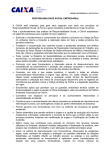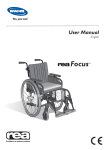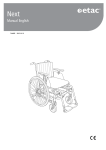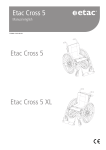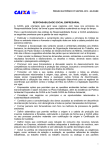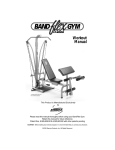Download Anterior Trunk Support User's Guide
Transcript
Anterior Trunk Support Specifications Angles of Attachment The angle that the shoulder harness attaches to the seating system or wheelchair frame determines the effectiveness for the user. Considerations: • The upper strap on the shoulder harness is mounted level with, or slightly above the shoulders. If the strap is attached lower than the shoulders, the strap will pull the shoulders downward. If the shoulder harness is mounted too high, the strap will be less effective at pulling the shoulders back. • T he Standard or Trimline shoulder harness is mounted so that the pad is on the clavicle at most times. This will prevent the pad from rubbing on the user’s neck or blocking the head of the humerus for arm movement. Also, if the pads are mounted too wide, the straps will tend to fall off of the user’s shoulders. The lower strap is mounted so that it is across the lower rib cage, not below the rib cage. If the strap is mounted too low, the harness will not be as effective in providing scapular retraction. • T he Trimline shoulder harness allows the most mounting options, because it is two separate pieces. TIGHTENING THE STRAPS Keep the shoulder harness tightened at the adjustment straps during fitting and daily use, to ensure correct pad placement. If the harness is too loose, many users will “hang” into the harness, rather than be positioned against the back support. If the user develops any redness from the shoulder harness, this may be due to incorrect fitting or from not adequately tightening the harness. This can lead to increased shear, or decreased pressure distribution under the harness itself. SIZING The shoulder harness size selection is determined by outside shoulder width. If the shoulder width falls between two sizes, consider other factors such as growth, weight changes and clothing. Bodypoint Anterior Trunk Supports are available in pediatric to adult sizes in both Standard and Trimline styles. Stayflex™ is available in narrow versions especially suited to women. ATTACHING TO THE FRAME The top strap assembly attaches to the posterior surface of the back support. The lower strap assembly is attached with Cinch-Mount™ or Flat-Mount™ end-fittings. These provide a quick and easy method for achieving precise adjustments when fitting the lower strap to the frame. Used in conjunction with the FrameSaver™ Clamp, a wide variety of suitable mounting locations can be created. Adjust webbing length in 3 easy steps! Patented Cinch-Mount™ Hardware: or Flat-Mount™ Hardware: 1 2 3 1 2 3 Stayflex™ Specifics and Options The Stayflex™ Anterior Trunk Support is an innovative, dynamic upper body support designed for unparalleled comfort and flexibility. The patent-pending design includes a stabilizing lower panel that limits vertical stretching and “riding up”. Combined with a strong elastic upper section, the stabilizing panel limits the overstretching and upward movement that can lead to choking in older “Butterfly” style supports. The soft, stretching material allows comfortable, controlled movement, rather than just holding the individual user back. The Stayflex™ is offered in a one-piece version or with a front zipper closure for easy removal. The new, low-profile swivel buckles prevent the fabric from twisting and bunching up around the lower straps. The Narrow version is designed to fit and support between breast tissue. Narrow Stayflex™ Harness Ideal Posture • Neutral alignment of spine and head • Level shoulders • Shoulders slightly posterior to pelvis • Neutral pelvis 95° 100° 90° Ideal angle of the back: 95-100° Anterior trunk supports should always be used in conjunction with a pelvic support or hip belt.* Anterior Trunk Support User’s Guide The trunk is important to postural alignment and stability as it dictates the position of the head and upper extremities. There are three points for trunk stabilization: the posterior trunk, the anterior trunk and the lateral trunk. Good posture is the result of balancing the skeleton in relation to gravity. The long-term goals of a good posture are to increase function of the user, minimize orthopedic consequences, provide pressure relief, normalize muscle tone and reduce active muscle requirements. Primary Support Surface Considerations • Fitted to the user • Solid seat and back provides increased support and stability •S eat to back support angle to accommodate range limitations and provide the trunk a position of rest • Correct back support height depends on the amount of trunk support needed • Correct back support width determined by widest posterior measurement. • Correct use of lateral trunk supports • Correct armrest height allows for 30° shoulder flexion and 60° elbow flexion • Achieve balance between support and function 800.547.5716 • www.bodypoint.com *See the Bodypoint Pelvic User’s Guide for more information on stabilizing the pelvis prior to applying anterior trunk support. 800.547.5716 • www.bodypoint.com WARRANTY: Most Bodypoint products carry a limited lifetime warranty against defects in workmanship and materials arising under normal use by the original consumer. Contact your supplier or Bodypoint for warranty claims. © Copyright Bodypoint 2011. All rights reserved. BMM037 June 2011 Rel 2 Trunk Kyphosis Trunk Scoliosis Assessment • Forward flexion of the upper trunk, usually thoracic area • Lumbar flexion, commonly with posterior pelvic tilt • Shoulders protracted • Little contact with the back • Individual may have to hyperextend neck to see straight ahead ASSESSMENT • Lateral flexion of the spine, usually the thoracic area • Can be C curve or S curve • Often seen in conjunction with pelvic obliquity • Shoulders are not level • Neck often flexed in the opposite direction to align visual field POSSIBLE CAUSES Wheelchair problems: seat-to-back angle too closed for available range of motion and inadequate support to prevent postural collapse. Physical conditions: flexible or fixed kyphosis of the spine, posterior pelvic tilt, tight hamstrings, tight hip flexors, low tone in trunk, and muscle weakness. ANTERIOR SUPPORT The goal of the anterior trunk support is to extend the trunk and retract the scapulas, reducing the kyphosis. This aligns the trunk over the pelvis, improves respiratory capacity, increases safe swallow, increases head control, maintains a good visual field and improves overall pressure distribution. anterior support PURPOSE The objective of the shoulder harness is to extend the trunk and retract the scapulas. Uncorrected posture Improved positioning with a Standard Shoulder Harness Physical conditions: flexible or fixed lateral scoliosis of the spine, pelvic obliquity, increased and asymmetrical muscle tone (shortening one side of the trunk) low tone in trunk and muscle weakness. anterior support Options Standard Shoulder Harness POSSIBLE CAUSES Wheelchair problems: inadequate postural support to prevent postural collapse to the side and inadequate lateral support. Uneven seating surfaces, or a chair that is too wide for the user may cause the user to lean to one side to gain lateral or armrest support. Trimline Shoulder Harness Trunk Rotation Assessment • Hyper-extension of the spine, usually the lumbar area • Often seen in conjunction with anterior pelvic tilt • Shoulders retracted • Limited contact with the back support ASSESSMENT • Rotation of the spine, usually the thoracic area • Can be double rotation, where a user with a rotated lower spine may rotate the upper spine in a compensatory posture in order to face forward. • Often seen in conjunction with pelvic rotation • Can be seen in combination with scoliosis (rotational scoliosis) • One shoulder is forward Physical conditions: flexible or fixed lordosis of the spine, tight hip flexors, increased muscle tone, low tone in trunk, muscle weakness, and “fixing” pattern to extend trunk against gravity. ANTERIOR SUPPORT The goal of the anterior trunk support is to provide pressure to the sternum, reducing the lordosis and pelvic anterior tilt. This aligns the trunk over the pelvis and reduces shoulder retraction and fixing to facilitate function. If the individual is capable of active trunk flexion, dynamic support may allow more anterior movement for functional reach, while still providing stability and improved posture. For some users, reducing lordosis may require additional postural support at the lower ribs and abdomen. Uncorrected posture. anterior support PURPOSE The objective of the shoulder harness is to provide pressure over the sternum to reduce thoracic and lumbar hyperextension and encourage more shoulder protraction. Improved positioning with a Stayflex™ Anterior Trunk Support. Physical conditions: pelvic rotation and increased and asymmetrical muscle tone, shortening one side of the trunk. Stayflex™ Anterior Trunk Support Attachment Options Be careful not to over-tighten and be certain that the pads are appropriately placed, to prevent the shoulders from being blocked in movement. If necessary, position the user with one hand while tightening the front or rear pull strap. POSSIBLE CAUSES Wheelchair problems: inadequate postural support to prevent pelvic rotation and poorly fitted, contoured back support. Improved positioning with Crossover Trimline Shoulder Harness ANTERIOR SUPPORT PURPOSE The objective of the support is to bring the user into a more midline, symmetrical trunk posture. anterior support Options Sometimes, only a chest belt is needed to maintain the user between the lateral supports. Chest belts are available padded, as needed. A Dynamic Chest Belt, such as the Monflex™ shown, can be used to allow additional range of motion. ANTERIOR SUPPORT The goal of the anterior trunk support is to work in conjunction with appropriately placed lateral trunk and pelvic pads to align the trunk to midline. This allows the head to be level over the trunk for vision. Trunk Lordosis POSSIBLE CAUSES Wheelchair problems: seat-to-back angle too closed so that the individual has to over extend to remain upright, reversed biangular back, and inadequate support to prevent postural collapse. Uncorrected posture. Uncorrected posture. Improved posture with a backpack position Trimline Shoulder Harness anterior support PURPOSE The objective of the support is to de-rotate the trunk. ANTERIOR SUPPORT The goal of the anterior trunk support is to pull the forward shoulder back so that the trunk is aligned in the sagittal plane and the user can face forward without neck rotation for vision, swallowing, and breathing. anterior support Options Sometimes, only a single shoulder harness strap is required on the forward side. Trimline Configuration Options Rear–Pull Rear-pull attachment is ideal for use with thicker backrests, or when you want the buckle or adjustment away from the user. NOTE: Side-release buckles may be removed to provide a continuous length of straight webbing for use with cam buckles or other mounting hardware. Front–Pull Front-pull attachment provides maximum stability while allowing adjustment standing either behind or in front of the user. Backpack Position Promotes respiration by encouraging shoulder retraction and trunk extension. Crossover position Provides a comfortable fit which does not restrict arm movement. This configuration helps reduce trunk extension.


